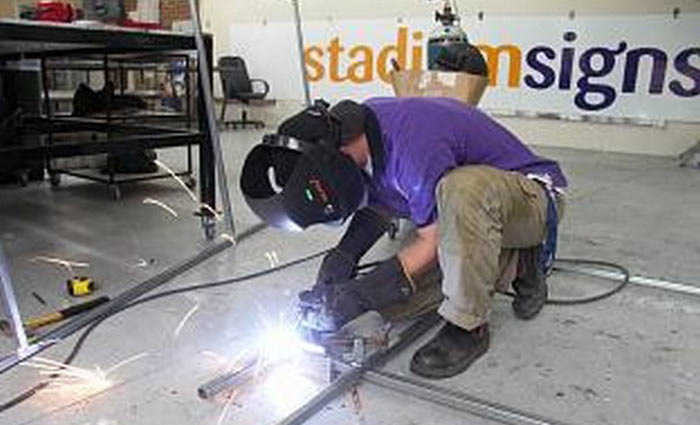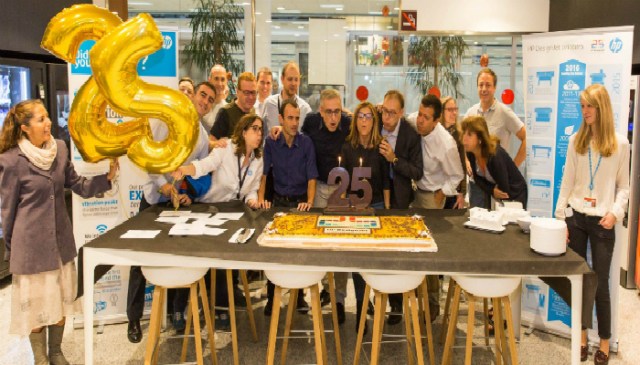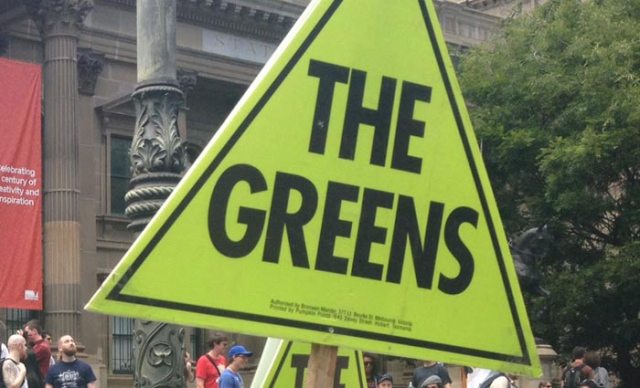

It's been 25 years since I took over a small shed-based signage business in Melbourne that's today known as Stadium Signs.
The industry has changed a lot in that time. I'm a qualified sign writer, but these days I'm more likely to talk pixels than paint, and I've swapped the paint and vinyl cutters for cutting-edge technology.
[Photos: 25 years of history]
But I'm getting ahead of myself… Back in 1988, I'd completed my indentures and had spent time working all over Australia on a wide range of signage projects, most of them hand-lettered or painstakingly assembled from multiple layers of hand-cut vinyl.
I enjoyed the work, but had ambitions to strike out on my own, so when a small signage business called Bradley Signs in Wonga Park came up for sale in 1988, I bought it for $10,000.
It seemed like the perfect way to do it; I now had an established business with a couple of good clients and a bit of equipment I could move into the shed at the back of my place.
As luck would have it, one of my new firm's clients was contracted to produce a couple of signs for advertising at the Melbourne Cricket Ground. I was soon regularly producing hand-painted boundary signs, which in those days were mainly for tobacco companies. I even changed our name in 1998 to Stadium Signs to reflect this speciality.
Quality work and good service, as it so often does, saw the business grow. I hired my first staff in 1988. I also made sure we kept up with technology by installing CCV (computer cut vinyl) technology in the late 1980s and our first computer and plotter in 1988 for $35,000.
The computer was a huge investment. It sounds incredible now, but it was unusual for businesses to own one in those days, and of course they were nowhere near as affordable as they are now. It saved us an enormous amount of time by allowing us to save the physical details of jobs for repeat work or to modify for similar jobs.
The computer installation was one of many pivotal moments in Stadium Signs' history. Another came about by chance.
One day in 1989, I was walking across the MCG with all my gear when I met a bloke coming the other way. We got chatting and when he found out I was working on the signage, he casually said, "Would you like to do a few more?" Naturally, I said yes, and that conversation saw our original contract for six signs grow to the point where today we manage about 95% of the above-ground signage at the ground – that’s parapets, tri-visions, sight-screens, behind wicket, players' benches and more.
In the early 2000s, Stadium Signs made its first investment in the digital technology that took over from CCV and also in digital print systems. Digital print really revolutionised our trade, not only because of the range and quality of images we could print economically for signage, like photographs, but also because it meant we could produce images on a much wider range of materials and expand our product range.
Stadium Signs has done many high-profile jobs over the years including the Commonwealth Games in 2006, the soccer World Cup qualifier against Uruguay in 2001, about 20 AFL grand finals, all the Boxing Day test matches and all the one-day cricket internationals. Alongside the MCG work, Stadium Signs took on the creation of the advertising signage infrastructure at Etihad Stadium (or Colonial Stadium as it was then called) when the ground opened in 2000.
Stadium Signs was busy and had a stable workforce of three or four staff along with a pool of contractors it could call on. It seemed like the business had found a comfortable spot – but I was worried. Our client base was narrow, our work was seasonal, and the profitability of some of our jobs was doubtful. Like many tradies who start their own businesses, I had reached the limitations of my expertise and didn't know which way to move next.
I found the solution in 2009 in the form of experienced and award-winning film and television post-producer Pamela Hammond. She had worked on high-budget international productions like The Bank Job, Charlotte’s Web, Chopper and Hark Tsui’s Chinese masterpiece, Seven Swords, as well as most of the popular Australian TV series like Sea Change, City Homicide and Secret Life of Us, but was also facing the 'Where to next?' question. In another of those pivotal moments, our paths crossed.
It turned out to be the perfect partnership. My creativity and production expertise complemented Pamela’s strong management, marketing and business skills. She helped Stadium Signs diversify its client base and move into new product lines so it was no longer dependent on a few key clients or the calendar. One of the biggest gifts Pamela gave Stadium Signs was her faith and commitment to encourage change and growth by up-skilling the existing staff, employing new staff and appointing a director of people management who is guiding us with staff realignment. A whole brave new world!
We moved to a much larger and more modern production facility in Ferntree Gully in 2012. We now have seven fulltime staff. Our key clients include the MCG and some of the highest profile corporate and sporting event companies in Australia, for which we produce everything from sporting and standard signage to experiential branding, fleet vehicle wrapping, fabric wall treatments and bespoke products.
Back in 1998, I couldn't possibly have foreseen the advances that have led us to where we are today. I'm sure the pace of change will continue, but as long as we focus on building great relationships with our clients and provide them with the best solutions, the future will take care of itself.
[Related: More Industry Insider columns]
Leigh Onions is a director of Stadium Signs
Comment below to have your say on this story.
If you have a news story or tip-off, get in touch at editorial@sprinter.com.au.
Sign up to the Sprinter newsletter



